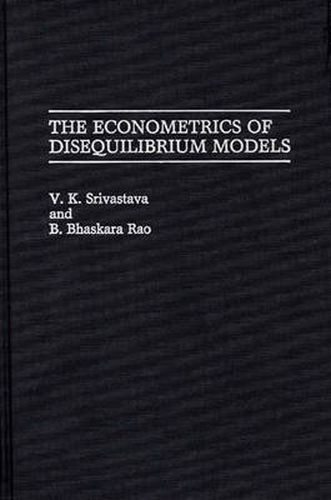Readings Newsletter
Become a Readings Member to make your shopping experience even easier.
Sign in or sign up for free!
You’re not far away from qualifying for FREE standard shipping within Australia
You’ve qualified for FREE standard shipping within Australia
The cart is loading…






An examination of the nature of disequilibrium models. The authors contend that existing software packages can be easily used to implement some of the relatively simple methods. This study furnishes a grounding in the economics and econometrics of the disequilibrium models by reviewing the Walrasian general equilibrium theory and by comparing the two genuine alternative frameworks for analyzing economic phenomena. Srivastava and Rao demonstrate that while both frameworks share a common set of basic assumptions about the behaviour of the economic decision-making units, they differ in their assumptions about the ability of the markets to attain equilibrium within a single trading period and whether trading can take place out of equilibrium. The first two chapters provide background information, divide the existing methods of estimation of disequilibrium models into two categories, and explain the estimation methods for the basic model that belongs to the first category. The next three chapters explain the estimation methods for the directional, quantitative, and generalized stochastic models of the second category. Various methods for testing and evaluating equilibrium versus disequilibrium hypotheses are investigated in chapter six. Chapter seven examines the assumptions on which the models are formulated and discusses some alternative specifications of the disequilibrium models. The final chapters provide analyses of the economics and econometrics of the multi-market models and illustrate how some simple estimation methods can be used to estimate the disequilibrium formulations of the US labour market. This volume will aid in the achievement of methodological consistency between analytical philosophy and the estimation methods in the applied work on disequilibrium economics.
$9.00 standard shipping within Australia
FREE standard shipping within Australia for orders over $100.00
Express & International shipping calculated at checkout
An examination of the nature of disequilibrium models. The authors contend that existing software packages can be easily used to implement some of the relatively simple methods. This study furnishes a grounding in the economics and econometrics of the disequilibrium models by reviewing the Walrasian general equilibrium theory and by comparing the two genuine alternative frameworks for analyzing economic phenomena. Srivastava and Rao demonstrate that while both frameworks share a common set of basic assumptions about the behaviour of the economic decision-making units, they differ in their assumptions about the ability of the markets to attain equilibrium within a single trading period and whether trading can take place out of equilibrium. The first two chapters provide background information, divide the existing methods of estimation of disequilibrium models into two categories, and explain the estimation methods for the basic model that belongs to the first category. The next three chapters explain the estimation methods for the directional, quantitative, and generalized stochastic models of the second category. Various methods for testing and evaluating equilibrium versus disequilibrium hypotheses are investigated in chapter six. Chapter seven examines the assumptions on which the models are formulated and discusses some alternative specifications of the disequilibrium models. The final chapters provide analyses of the economics and econometrics of the multi-market models and illustrate how some simple estimation methods can be used to estimate the disequilibrium formulations of the US labour market. This volume will aid in the achievement of methodological consistency between analytical philosophy and the estimation methods in the applied work on disequilibrium economics.